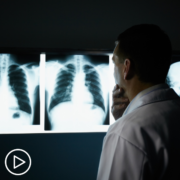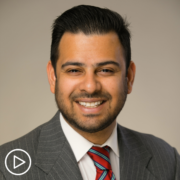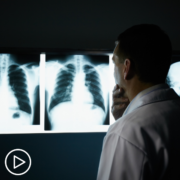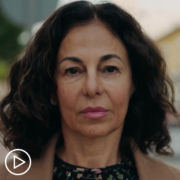LC Programs Archives
For more resources and support related to Lung Cancer Programs, please visit our main health center page.
Click here for Lung Cancer.
Advice for Accessing Financial Resources for Lung Cancer Care
Advice for Accessing Financial Resources for Lung Cancer Care from Patient Empowerment Network on Vimeo.
Is there financial assistance available for lung cancer patients? Lung cancer expert Dr. Jyoti Patel shares support resources and tips to help reduce the financial burden of treatment.
Jyoti Patel, MD, is Medical Director of Thoracic Oncology and Assistant Director for Clinical Research at the Robert H. Lurie Comprehensive Cancer Center of Northwestern University. She is also Associate Vice-Chair for Clinical Research and a Professor in the Division of Hematology and Oncology at Northwestern University Feinberg School of Medicine. Dr. Patel is a leader in thoracic oncology, focusing her efforts on the development and evaluation of novel molecular markers and therapeutics in patients battling non-small cell lung cancer. Learn more about Dr. Patel.
See More from Thrive Lung Cancer
Related Resources:

|

|

|
Transcript:
Katherine:
Dr. Patel, we’d be remiss if we didn’t bring up financial concerns.
Treatment and regular appointments can become quite expensive. So, understanding that everyone’s situation is different, where can patients turn to if they need resources for financial support?
Dr. Patel:
When your team first talks to you about therapies, it’s important that they have transparency about what something may cost or the risks that you may incur by starting treatment. However, most of us have access to wonderful financial teams and financial counselors that can help you manage this.
Many of our industry partners and friends are able to have assistance programs to provide oral drugs at discounted rates or to work, again, with organizations in which you may be able to have reduced rates for many of your drugs. Most of the infusional drugs, again, should be covered by insurance. But outside of drug costs, there are a lot of other costs.
So, parking every time you come for a doctor’s appointment. Time off from work. Time that you’re hiring a babysitter to take care of your children when you’re at treatment. All of those add up. And so, again, perhaps talking to the social worker at your cancer center or talking to the financial counselor, there are often local programs that can help ease some of those burdens.
Tips for Managing Lung Cancer Anxiety and Worry
Tips for Managing Lung Cancer Anxiety and Worry from Patient Empowerment Network on Vimeo.
Lung cancer expert Dr. Jyoti Patel shares support resources to help ease anxiety and explains how multidisciplinary care teams, including palliative care, can support patients and family members.
Jyoti Patel, MD, is Medical Director of Thoracic Oncology and Assistant Director for Clinical Research at the Robert H. Lurie Comprehensive Cancer Center of Northwestern University. She is also Associate Vice-Chair for Clinical Research and a Professor in the Division of Hematology and Oncology at Northwestern University Feinberg School of Medicine. Dr. Patel is a leader in thoracic oncology, focusing her efforts on the development and evaluation of novel molecular markers and therapeutics in patients battling non-small cell lung cancer. Learn more about Dr. Patel.
See More from Thrive Lung Cancer
Related Resources:

|

|

|
Transcript:
Katherine:
Managing the worry associated with a diagnosis or concerns about progression can lead to anxiety and fear in some patients. So, why is it important for patients to share how they’re feeling with their healthcare team? And who all is in the healthcare team who would be able to help a patient?
Dr. Patel:
So, the anxiety of cancer therapies, of CT scans, of tumor assessments, can be overpowering. And then the longer-term anxieties. Who’s going to care for me, who’s going to care for my family, am I doing the things that are important to me, are ones that weigh heavily on all of us.
So, certainly, again, carrying these anxieties over a long time have adverse impacts. So, people who are more anxious may not sleep as well. They may lose weight. They may not be as robust. And so, all of those things weigh into our ability to give more treatment. So, we want people to be psychologically well. We have, generally now in our healthcare teams, a number of people who are there to help.
And so, we have nurse navigators. Most cancer centers have a number of psychologists and psychiatrists that work with our teams. But more than that, even things like nutritionists and social workers make a significant impact. And then I’m surely lucky to work with a world-class palliative care team.
So, these are doctors that really focus on symptoms of cancer, the toxicities of treatment. And we work together to ensure the best outcome for our patients.
Advice for Managing Lung Cancer Symptoms and Treatment Side Effects
Advice for Managing Lung Cancer Symptoms and Treatment Side Effects from Patient Empowerment Network on Vimeo.
Lung cancer expert Dr. Jyoti Patel explains common symptoms and treatment side effects, and discusses how treatment approaches may vary depending on treatment goals for each patient.
Jyoti Patel, MD, is Medical Director of Thoracic Oncology and Assistant Director for Clinical Research at the Robert H. Lurie Comprehensive Cancer Center of Northwestern University. She is also Associate Vice-Chair for Clinical Research and a Professor in the Division of Hematology and Oncology at Northwestern University Feinberg School of Medicine. Dr. Patel is a leader in thoracic oncology, focusing her efforts on the development and evaluation of novel molecular markers and therapeutics in patients battling non-small cell lung cancer. Learn more about Dr. Patel.
See More from Thrive Lung Cancer
Related Resources:

|

|

|
Transcript:
Katherine:
Symptoms and side effects can sometimes be a burden to patients undergoing treatment. What are the most common issues that patients face?
Dr. Patel:
So, common symptoms from treatment can include fatigue, lack of appetite, disinterest in the things that made you really excited before. Infrequently now we have severe nausea, because we have such good antinausea medications.
Sometimes we’ll have problems with blood counts or risks of infection. All of these vary by the treatment that’s rendered. And so, often it may be that you’re on a targeted therapy.
Some targeted therapies, for example, can cause swelling in your legs. Immunotherapies are generally well-tolerated but can cause significant side effects in a small minority of people that could include inflammation in the gut, for example.
So, everything is sort of tailored, I would say. Most frequently, I hear about the fatigue, and then the ongoing stressors of living with cancer. So, the financial toxicity certainly. These drugs are expensive. But not only that, often people have changed the way they work. Their family members have changed how they work to support their loved one. So, bringing people to appointments.
There’s a lot on someone’s plate. And that can contribute to fatigue and even some anxiety.
Katherine:
Yeah. What strategies are in place to manage symptoms and side effects?
Dr. Patel:
So, having a patient who’s knowledgeable about potential side effects and a good advocate for themselves is probably the best way to manage therapy. So, ongoing dialogue with your clinical team, with your nurse, with your physician, are absolutely important. But most of us work with teams of healthcare workers. And so, when I think about our clinic, we have financial counselors, we have social workers, we have dieticians and nutritionists, we work with physical therapists. And importantly, we work with a palliative care team that helps us, again, manage some of the toxicities of therapy.
We think that they provide a longitudinal assessment of patients and remember what’s most important to a patient over time. Whereas often in the moment there’s this, we want to make the tumor shrink. We think about what we can do immediately. It’s often really helpful to have another team that can provide support over the patient’s journey to help us, again, prioritize what they wanted to do the most.
Katherine:
Mm-hmm. Dr. Patel, why do you think it’s necessary for patients to tell their doctor about any issues they may be having? Even the little ones.
Dr. Patel:
I think most of us want to be good patients. And so, we minimize things because we think that, okay, we’re using precious time to talk about things that may seem minor. But, again, all of these add up.
Even minor symptoms, particularly in the era of immunotherapy, can turn out to be big problems. So, as I say now to my patients particularly on immunotherapy, if something seems a little bit off and you can’t put your finger on it, I just need to know so I can at least do the appropriate workup to make sure that we’re not missing anything. Because symptoms of underlying problems can be very misleading.
Moreover, I think the cumulative burden of cancer. So, again, we talked a little bit about the financial toxicity, the emotional cost, the time involved in treatment, all of that adds up. And you never want to get it to a breaking point. We want to manage it early on, so we can, again, make decisions together and keep wellness and the quality of survival at the forefront.
Personalized Medicine | Making Lung Cancer Treatment Decisions
Personalized Medicine | Making Lung Cancer Treatment Decisions from Patient Empowerment Network on Vimeo.
Lung cancer expert Dr. Jyoti Patel explains how biomarker testing is used to guide treatment decisions and personalize care plans for patients.
Jyoti Patel, MD, is Medical Director of Thoracic Oncology and Assistant Director for Clinical Research at the Robert H. Lurie Comprehensive Cancer Center of Northwestern University. She is also Associate Vice-Chair for Clinical Research and a Professor in the Division of Hematology and Oncology at Northwestern University Feinberg School of Medicine. Dr. Patel is a leader in thoracic oncology, focusing her efforts on the development and evaluation of novel molecular markers and therapeutics in patients battling non-small cell lung cancer. Learn more about Dr. Patel.
See More from Thrive Lung Cancer
Related Resources:

|

|
Transcript:
Katherine:
Since no two people with lung cancer are the same, how do you decide which treatment is best for each patient?
Dr. Patel:
So, the process of evaluating a patient can actually take a little bit of time. So, we first meet a patient, and they may have suspicious findings. We want to understand the full stage of their cancer. And so, in 2022, that’s doing an MRI of the brain, a CT of the chest and abdomen, and often times a pet scan to look for any evidence of distant disease.
So, once we have radiographic modeling of where we think the tumor is, sometimes we need to do a repeat biopsy to confirm whether or not lymph nodes are involved or the cancer has spread. After we do the biopsy and say that it’s non-small cell lung cancer or small cell lung cancer, we make decisions about looking for genetic markers.
And so, we’ll often take the tumor tissue and stain for things like PD-L1, which is a marker of response to immunotherapies.
Very importantly, with all these new targeted therapies, we want to understand the genetic makeup of cancer. So, we want to look for things like EGFR mutations or ALK translocations which are more effectively treated with targeted therapies than chemotherapy or immunotherapy.
So, those are the tumor characteristics. But, again, I’ve said before, a tumor exists in a person.
And so, you need to understand what’s important to the person, what do they prioritize, what’s their health like, what, again, are the preferences, are there other comorbidities that could perhaps make some treatments more difficult? Many people, for example, have autoimmune disease. And so, that can be something that’s relatively minor, like some psoriasis that is well-controlled versus perhaps lupus which can cause organ failure.
Often with psoriasis there are ways that we can give immunotherapy safely. Sometimes other autoimmune diseases would put patients at very high risk with immunotherapies. And so, again, understanding the overall health, understanding other competing causes of toxicity, are absolutely important as you make decisions together.
Katherine:
Yeah. It seems like we’re getting closer to personalized medicine. For you, how would you define that term?
Dr. Patel:
Personalized medicine comes in two forms. So, one is the biologics of the tumor itself. So, what do I understand about the genetic markers, the likelihood of response to the available therapies. The other piece, again, is personalizing it to the person that has the cancer.
And so, again, what are the preferences? What are the risks they’re willing to take? What are their goals? What are the preferences?
Emerging Therapies | Hope for the Future of Lung Cancer Care
Emerging Therapies | Hope for the Future of Lung Cancer Care from Patient Empowerment Network on Vimeo.
Lung cancer expert Dr. Jyoti Patel provides updates about emerging research and shares her impressions about the future of lung cancer care.
Jyoti Patel, MD, is Medical Director of Thoracic Oncology and Assistant Director for Clinical Research at the Robert H. Lurie Comprehensive Cancer Center of Northwestern University. She is also Associate Vice-Chair for Clinical Research and a Professor in the Division of Hematology and Oncology at Northwestern University Feinberg School of Medicine. Dr. Patel is a leader in thoracic oncology, focusing her efforts on the development and evaluation of novel molecular markers and therapeutics in patients battling non-small cell lung cancer. Learn more about Dr. Patel.
See More from Thrive Lung Cancer
Related Resources:

|

|

|
Transcript:
Katherine:
I’d like to talk about emerging treatments. Are there any therapies in development that patients should know about that you’re excited about?
Dr. Patel:
There are a number of things that are happening right now in the landscape that is really, again, giving us great optimism about how to move forward. So, areas of active research really concentrate on identification of new targets so that we have identified oncogenes that we’re trying to treat effectively. So, those are things like EGFR Exon 20 mutations or HER2 mutations, as well as some of these new fusions.
Another area of rapidly growing research is that most patients who have targeted therapies will eventually develop resistance. And so, understanding how to mitigate resistance or how to overcome resistance is important. And we often talk about the different drugs in development as first-, second-, and third-generation drugs in the EGFR space, which accounts for about 15 percent of lung cancers in the United States. We’re looking at fourth-generation tyrosine kinase inhibitors. They’re certainly very exciting.
The other piece, I think, of research that is moving and that we are looking forward to understanding why some patients have really robust responses to immunotherapies and others don’t. Or how people become immune to the effects of immunotherapy. And so, understanding the tumor microenvironment, seeing if there are other proteins that we can co-stimulate to cause these robust and durable responses to immunotherapy is an area that we’re working on.
Katherine:
Before we close, I’d like to ask, are you hopeful about the potential for people with lung cancer to thrive?
Dr. Patel:
Absolutely. The future is bright after years of working and really developing this great foundational science.
We are seeing the transformation of cancer care in a way that is faster than I could’ve ever imagined at the beginning of my career. We’re bringing scientific insights to the bedside. And bringing it to the bedside is impacting how patients live with their cancer and thrive with their cancer. They’re living longer and with fewer toxicities and side effects than I ever imagined.
I’m optimistic about the promise of early detection through blood tests one day, through screening with CT scans to find early-staged disease in which the cancer is the most curable. And then for patients with more extensive disease, to really understand how we can sequence therapies or deescalate therapies when patients have minimal burden of disease, again, to decrease the toxicities
Tips for Managing Your Oral Lung Cancer Treatment
Tips for Managing Your Oral Lung Cancer Treatment from Patient Empowerment Network on Vimeo.
What happens if you miss a dose of your oral therapy? Lung cancer expert Dr. Jyoti Patel shares advice for managing oral lung cancer treatment for optimal patient care.
Jyoti Patel, MD, is Medical Director of Thoracic Oncology and Assistant Director for Clinical Research at the Robert H. Lurie Comprehensive Cancer Center of Northwestern University. She is also Associate Vice-Chair for Clinical Research and a Professor in the Division of Hematology and Oncology at Northwestern University Feinberg School of Medicine. Dr. Patel is a leader in thoracic oncology, focusing her efforts on the development and evaluation of novel molecular markers and therapeutics in patients battling non-small cell lung cancer. Learn more about Dr. Patel.
See More from Thrive Lung Cancer
Related Resources:

|

|

|
Transcript:
Katherine:
Are some of the targeted therapies taken orally? And if so, are patients in charge of administering them, their own therapies?
Dr. Patel:
Many of the targeted therapies that are most effective are taken orally. And so, patients take them at home. Often, they’ll have once-daily dosing or twice-daily dosing. The number of pills often depends on the formulation of the drug. So, patients are responsible, I guess, for taking them. That comes with a lot. So, we need to think about, how do we help with adherence? How do we manage toxicity? How are the drugs affected by whether you eat or take the drug on an empty stomach? There are a lot of nuances there.
Generally, we like to give a lot of information to our patients. So, often, patients will meet with a pharmacist when they’re first prescribed the medication. They’ll meet with our nurses to go over how to take those and how to manage any side effects if they have them or what to do if there are any adverse reactions.
Katherine:
Mm-hmm. Well, what would happen if a patient forgets to take one of their medications? Does that impact its effectiveness? And then should they get in touch with their healthcare team to let them know?
Dr. Patel:
So, generally, we like patients to take the medication almost at the same time every day. We sort of think about half-life. So, we want to make sure that that serum level stays appropriate. If someone misses a dose – which happens – and, again the best-case scenario is that people are on these pills for years, right? For several years. So, of course, you’re going to miss a dose. If that happens, we generally tell people never to double up.
To let your team know. Often you can just skip that dose and take it in the evening or the next day.
How Is Lung Cancer Treated?
How Is Lung Cancer Treated? from Patient Empowerment Network on Vimeo.
Lung cancer expert Dr. Jyoti Patel provides an overview of lung cancer treatment approaches, including radiation therapies, targeted therapies, immunotherapy, chemotherapy, and surgery.
Jyoti Patel, MD, is Medical Director of Thoracic Oncology and Assistant Director for Clinical Research at the Robert H. Lurie Comprehensive Cancer Center of Northwestern University. She is also Associate Vice-Chair for Clinical Research and a Professor in the Division of Hematology and Oncology at Northwestern University Feinberg School of Medicine. Dr. Patel is a leader in thoracic oncology, focusing her efforts on the development and evaluation of novel molecular markers and therapeutics in patients battling non-small cell lung cancer. Learn more about Dr. Patel.
See More from Thrive Lung Cancer
Related Resources:

|

|

|
Transcript:
Katherine:
I’d like to walk through the types of treatments that are used today to treat lung cancer. Let’s start with surgery.
Dr. Patel:
We think about local therapies as things like surgery. So, surgery has evolved, again, significantly.
Now with videoscopic approaches and robotic approaches we’re able to remove a tumor either with a larger incision – more traditional incision – or some of the smaller incisions. And the goal of doing the surgery is often to want to diagnosis the cancer. So, to do a biopsy. But when it’s used in terms of cancer treatment, the goal of surgery is to get a complete resection.
So, we only do surgery if we can remove a tumor and mass with clear margins and not compromise other vital functions. Sometimes we’ll, again, do a more palliative surgery if we need to, if there’s a problem that’s causing significant symptoms. But in that case, the surgery is generally not improving the survival of the patient. It’s trying to palliate symptoms.
Katherine:
Mm-hmm. What about other types of therapy?
Dr. Patel:
Other localized therapies predominately include radiation therapy. And, again, radiation has significantly changed over the past years. We’ve been able to incorporate new technologies, truly target tumors, and to minimize toxicity, with two kinds of radiation. Photon therapy, which is more traditional therapy, and proton therapy, which we see administered in a very small subset of patients.
Primarily, photon therapy, we treat tumors, sometimes over many weeks, to decrease toxicity versus sometimes we give one or two doses of radiation in a high-dose fashion that’s very targeted. So, often for the chest in stage III cancer, for example, a patient may end up getting six weeks of radiation Monday to Friday with chemotherapy.
And that, again, is curative intent. It’s to ablate the cancer and to provide the best local treatment.
Often, we’ll do something called stereotactic radiation therapy. And that is if there is a discreet mass, often that could be if the cancer is metastasized to the brain, we can give very targeted radiation there, again, to ablate the tumor.
In patients who may not be candidates for surgery because lung surgery is a big deal, right? Removing part of your lung can lead to morbidity in someone with other medical issues. Sometimes we can use pinpoint radiation in the lung and see really good outcomes for patients with good disease control.
Katherine:
You’re also using chemotherapy still, I would imagine?
Dr. Patel:
The other part of treatment for lung cancer are systemic therapies. And there a number of systemic therapies. So, I sort of break it down into three major parts. One is chemotherapy. Chemotherapy remains a backbone of treatment for lung cancer.
It’s a lot more tolerable and much more personalized than ever before. Often chemotherapy can be given to patients without significant toxicities. Not everyone loses their hair. Not everyone has neuropathy. Often, I have patients who are working and taking care of their families on chemotherapy. So, it is a good and very reasonable option. But two things that we’re really most excited about – and I think have changed the field most dramatically – are targeted therapies and immunotherapies.
Katherine:
Mm-hmm.
Dr. Patel:
These targeted therapies are rationally designed molecules or antibodies that block proteins that may be overexpressed in lung cancer.
So, some of them are the byproducts of mutated genes that are upregulated and causing a cancer to grow. Others may just be that we’re seeing a high level of protein expression on the cancer cell. But these targeted therapies preferentially bind to their targets that are present on cancer cells and not so much normal cells. Because of this, often there is less toxicity to normal cells. But because we can find specific targets – and the best targets are ones that are only expressed on cancer cells.
But because we can find a direct target, sometimes we’re able to design drugs that may have significant efficacy. So, 80 percent or 90 percent of people who have a particular target and are able to get a targeted therapy may have a response to treatment. Targeted therapy can be great for some patients. And patients may be on oral medications, sometimes for years, to control their cancer.
The other real game-changer in the past decade for lung cancer has been the integration of immunotherapy. Approved immunotherapies currently are primarily antibodies that we give to patients. And these antibodies block proteins that are expressed by cancer cells which downregulate the immune system. By shutting down these proteins, your own immune system is able to kind of re-see the cancer cell and kill it.
And so, now we know in patients with more advanced disease that immunotherapy or immunotherapy with chemotherapy leads to better outcomes than we’ve ever seen. We also use immunotherapy for patients with stage III lung cancer after chemotherapy and radiation. And this improves their survival significantly.
And most recently, we’ve now integrated immunotherapy after surgery for patients with early-staged disease to decrease their chance of relapse from cancer.
Katherine:
So, are there options for relapsed patients?
Dr. Patel:
So, absolutely. Most of our therapies in the metastatic setting work for some time. And then cancer is a difficult adversary. It figures out how to overcome whatever strategy we’re using and becomes resistant. When that happens, often we need to change course. We need to try a new therapy. We have a number of therapies that we’re looking at in the first- and second-line settings. And we’re trying to understand best therapies for subsequent lines of treatment.
Generally, I say treatment is appropriate if you’re feeling pretty well, right? If you’re able to tolerate treatment, then the likelihood that you would be able to benefit from therapy is significant. How that changes over time weighs heavily on our decision. So, if someone’s having more fatigue or more symptoms from their cancer, it may be that even a little bit of toxicity proves too much.
Whereas if someone is feeling still really good, we may be willing to say, okay, I’m going to take a little bit more of a risk for the benefit of improved cancer control.
Understanding Lung Cancer Treatment Goals
Understanding Lung Cancer Treatment Goals from Patient Empowerment Network on Vimeo.
Lung cancer expert Dr. Jyoti Patel explains small cell lung cancer versus non-small cell lung cancer (NSCLC) and how treatment goals may vary by disease stage and patient factors.
Jyoti Patel, MD, is Medical Director of Thoracic Oncology and Assistant Director for Clinical Research at the Robert H. Lurie Comprehensive Cancer Center of Northwestern University. She is also Associate Vice-Chair for Clinical Research and a Professor in the Division of Hematology and Oncology at Northwestern University Feinberg School of Medicine. Dr. Patel is a leader in thoracic oncology, focusing her efforts on the development and evaluation of novel molecular markers and therapeutics in patients battling non-small cell lung cancer. Learn more about Dr. Patel here: Dr. Patel.
See More from Thrive Lung Cancer
Related Resources:

|

|

|
Transcript:
Katherine:
Before we get into treatment though, I’d like you to walk us through the types of lung cancer if you would.
Dr. Patel:
Sure. So, over 200,000 Americans will be diagnosed with lung cancer this year. And we break lung cancer down into two major diagnoses. So, the more common one is non-small cell lung cancer. The less common one, which accounts for 13 percent of diagnoses, is small cell lung cancer. Those are descriptive terms but don’t really go beyond that. It’s, essentially, what do the cells look like under the microscope? We know that these two behave very differently. Small cell lung cancer tends to be a cancer which can move a little bit more quickly. It tends to be more aggressive.
We have certain treatment regimens that are appropriate. Non-small cell lung cancer is one which we further subdivide into adenocarcinoma, squamous cell cancer, or large neuroendocrine cancer. And we treat those a little bit more similarly with different local therapies and different systemic agents.
Katherine:
Okay. How would you define treatment goals for people with lung cancer?
Dr. Patel:
So, we hope that the number of patients that we find with earlier stage disease increases as we now at least have evidence to do screening for people who are at high risk. So, for patients with early-stage disease, which we really define as stage I and stage II – so, cancer that’s limited to the lobe of a lung – our best treatment options are surgery and sometimes radiation in appropriate patients. And for those patients, we think that treatment is discreet and curative.
For the third of patients who present with stage III disease or locally-advanced disease – and here we’ve seen significant advancements with the integration of immunotherapies, improvements in surgery, and radiation. Their treatment course tends to be a bit longer but, again, our intent is curative. So, the cancer has discreet therapy, we complete it, and then patients are in survivorship mode, in which we’re following them periodically.
Unfortunately, still, a large number of patients present with more advanced disease. Stage IV disease or metastatic disease. Those are all sort of interchangeable. And treatment for those patients is about controlling the cancer. Often, you’ll hear the word “palliative.” So, the goal of treatment is to control the cancer, to decrease the burden of cancer, and to help patients live longer. Certainly, again, with our advancements of immunotherapies and targeted therapies, patients are living longer than ever before.
And in some patients, it really becomes a chronic disease in which checkups can be periodically done or patients can be monitored off of treatment for long periods.
Katherine:
Mm-hmm. Do treatment goals vary by lung cancer type?
Dr. Patel:
So, the goal of cancer treatment is always to make patients live longer and to make sure that that quality of that survival is the best it can be. So, that’s always our overlying goal. For patients with early disease or early stage – stage I to III non-small cell lung cancer – is something we call limited stage. Small cell lung cancer, the intent is, again, curative. For patients with more advanced disease, we tend to think about the cancer as something that we control, that we see a good response to hopefully, and watch patients over time.
There are a subset of patients with more advanced disease that have really significantly better outcomes. We call these sort of patients “super survivors.” And we hope to make that number greater as we incorporate new science into their treatment paradigms.
Katherine:
What is the role of patients in making treatment decisions?
Dr. Patel:
I think all treatment decisions are patient-focused.
So, again, understanding someone’s goals of treatment are important. But understanding the context in which the cancer is happening. So, the cancer is part of a patient that has a really full life. Family. Work. Other medical comorbidities. Things that they prioritize. And so, having open discussion about the likelihood of achieving curative therapy or what the risks and benefit ratios are in palliative therapy are absolutely essential to having transparent and honest communication with patients. But it is also optimistic and compassionate.
Thriving With Lung Cancer: What You Should Know About Care and Treatment
Thriving With Lung Cancer: What You Should Know About Care and Treatment from Patient Empowerment Network on Vimeo.
What does it mean to thrive with lung cancer? Dr. Jyoti Patel discusses care and treatment goals, reviews current and emerging treatment options, and shares advice for living well and thriving with lung cancer.
Jyoti Patel, MD, is Medical Director of Thoracic Oncology and Assistant Director for Clinical Research at the Robert H. Lurie Comprehensive Cancer Center of Northwestern University. She is also Associate Vice-Chair for Clinical Research and a Professor in the Division of Hematology and Oncology at Northwestern University Feinberg School of Medicine. Dr. Patel is a leader in thoracic oncology, focusing her efforts on the development and evaluation of novel molecular markers and therapeutics in patients battling non-small cell lung cancer. Learn more about Dr. Patel.
See More from Thrive Lung Cancer
Related Resources:

|

|

|
Transcript:
Katherine:
Hello and welcome. I’m Katherine Banwell, your host for today’s program. Today’s webinar focuses on how patients can aim to live well and thrive with lung cancer. We’re going to discuss treatment goals and the importance of patients playing an active role in their care. Before we get into the discussion, please remember that this program is not a substitute for seeking medical advice. Please refer to your healthcare team about what might be best for you. Let’s meet our guest today. Joining me is Dr. Jyoti Patel. Dr. Patel, welcome. Would you please introduce yourself?
Dr. Patel:
Hi. Thanks so much. My name is Jyoti Patel. I’m a professor in medicine at the Northwestern University Lurie Cancer Center and I’m the medical director of thoracic oncology and the vice chair of clinical research for the Department of Medicine.
Katherine:
Well, thank you so much for taking the time out of your busy schedule to be with us today. Since this webinar is part of PEN’s Thrive series, I’d like to ask you from your clinical experience and perspective, what do you think it means to thrive with lung cancer?
Dr. Patel:
I think our definition of that has evolved considerably over the past two decades. The advancements in the lab and in clinical trials have translated to vastly different outcomes from our patients than I ever imagined two decades ago. So, certainly we see a large number of lung cancer survivors, people who have had early disease that has been eradicated and they are living after their lung cancer diagnosis with sequela treatment. And we see an even larger number of patients who are in active treatment, those with more advanced disease.
When we can minimize the toxicities of active treatment and really focus on quality of life, survival outcomes, then I think we’re really talking about thriving with lung cancer.
Katherine:
Mm-hmm. Well, thank you for your insights. Of course, an appropriate treatment course is part of thriving. Before we get into treatment though I’d like you to walk us through the types of lung cancer if you would.
Dr. Patel:
Sure. So, over 200,000 Americans will be diagnosed with lung cancer this year. And we break lung cancer down into two major diagnoses. So, the more common one is non-small cell lung cancer. The less common one, which accounts for 13 percent of diagnoses, is small cell lung cancer. Those are descriptive terms but don’t really go beyond that. It’s, essentially, what do the cells look like under the microscope? We know that these two behave very differently. Small cell lung cancer tends to be a cancer which can move a little bit more quickly. It tends to be more aggressive.
We have certain treatment regimens that are appropriate. Non-small cell lung cancer is one which we further subdivide into adenocarcinoma, squamous cell cancer, or large neuroendocrine cancer. And we treat those a little bit more similarly with different local therapies and different systemic agents.
Katherine:
Okay. How would you define treatment goals for people with lung cancer?
Dr. Patel:
So, we hope that the number of patients that we find with earlier stage disease increases as we now at least have evidence to do screening for people who are at high risk. So, for patients with early-stage disease, which we really define as stage I and stage II – so, cancer that’s limited to the lobe of a lung – our best treatment options are surgery and sometimes radiation in appropriate patients. And for those patients, we think that treatment is discreet and curative.
For the third of patients who present with stage III disease or locally-advanced disease – and here we’ve seen significant advancements with the integration of immunotherapies, improvements in surgery, and radiation. Their treatment course tends to be a bit longer but, again, our intent is curative. So, the cancer has discreet therapy, we complete it, and then patients are in survivorship mode, in which we’re following them periodically.
Unfortunately, still, a large number of patients present with more advanced disease. Stage IV disease or metastatic disease. Those are all sort of interchangeable. And treatment for those patients is about controlling the cancer. Often, you’ll hear the word “palliative.” So, the goal of treatment is to control the cancer, to decrease the burden of cancer, and to help patients live longer. Certainly, again, with our advancements of immunotherapies and targeted therapies, patients are living longer than ever before.
And in some patients, it really becomes a chronic disease in which checkups can be periodically done or patients can be monitored off of treatment for long periods.
Katherine:
Mm-hmm. Do treatment goals vary by lung cancer type?
Dr. Patel:
So, the goal of cancer treatment is always to make patients live longer and to make sure that that quality of that survival is the best it can be. So, that’s always our overlying goal. For patients with early disease or early stage – stage I to III non-small cell lung cancer – is something we call limited stage. Small cell lung cancer, the intent is, again, curative. For patients with more advanced disease, we tend to think about the cancer as something that we control, that we see a good response to hopefully, and watch patients over time.
There are a subset of patients with more advanced disease that have really significantly better outcomes. We call these sort of patients “super survivors.” And we hope to make that number greater as we incorporate new science into their treatment paradigms.
Katherine:
What is the role of patients in making treatment decisions?
Dr. Patel:
I think all treatment decisions are patient-focused.
So, again, understanding someone’s goals of treatment are important. But understanding the context in which the cancer is happening. So, the cancer is part of a patient that has a really full life. Family. Work. Other medical comorbidities. Things that they prioritize. And so, having open discussion about the likelihood of achieving curative therapy or what the risks and benefit ratios are in palliative therapy are absolutely essential to having transparent and honest communication with patients. But it is also optimistic and compassionate.
Katherine:
You mentioned some treatment approaches a few moments ago, but I’d like to walk through the types of treatments that are used today to treat lung cancer. Let’s start with surgery.
Dr. Patel:
We think about local therapies as things like surgery. So, surgery has evolved, again, significantly.
Now with videoscopic approaches and robotic approaches we’re able to remove a tumor either with a larger incision – more traditional incision – or some of the smaller incisions. And the goal of doing the surgery is often to want to diagnosis the cancer. So, to do a biopsy. But when it’s used in terms of cancer treatment, the goal of surgery is to get a complete resection.
So, we only do surgery if we can remove a tumor and mass with clear margins and not compromise other vital functions. Sometimes we’ll, again, do a more palliative surgery if we need to, if there’s a problem that’s causing significant symptoms. But in that case, the surgery is generally not improving the survival of the patient. It’s trying to palliate symptoms.
Katherine:
Mm-hmm. What about other types of therapy?
Dr. Patel:
Other localized therapies predominately include radiation therapy. And, again, radiation has significantly changed over the past years. We’ve been able to incorporate new technologies, truly target tumors, and to minimize toxicity, with two kinds of radiation. Photon therapy, which is more traditional therapy, and proton therapy, which we see administered in a very small subset of patients.
Primarily, photon therapy, we treat tumors, sometimes over many weeks, to decrease toxicity versus sometimes we give one or two doses of radiation in a high-dose fashion that’s very targeted. So, often for the chest in stage III cancer, for example, a patient may end up getting six weeks of radiation Monday to Friday with chemotherapy.
And that, again, is curative intent. It’s to ablate the cancer and to provide the best local treatment.
Often, we’ll do something called stereotactic radiation therapy. And that is if there is a discreet mass, often that could be if the cancer is metastasized to the brain, we can give very targeted radiation there, again, to ablate the tumor.
In patients who may not be candidates for surgery because lung surgery is a big deal, right? Removing part of your lung can lead to morbidity in someone with other medical issues. Sometimes we can use pinpoint radiation in the lung and see really good outcomes for patients with good disease control.
Katherine:
You’re also using chemotherapy still, I would imagine?
Dr. Patel:
The other part of treatment for lung cancer are systemic therapies. And there a number of systemic therapies. So, I sort of break it down into three major parts. One is chemotherapy. Chemotherapy remains a backbone of treatment for lung cancer.
It’s a lot more tolerable and much more personalized than ever before. Often chemotherapy can be given to patients without significant toxicities. Not everyone loses their hair. Not everyone has neuropathy. Often, I have patients who are working and taking care of their families on chemotherapy. So, it is a good and very reasonable option. But two things that we’re really most excited about – and I think have changed the field most dramatically – are targeted therapies and immunotherapies.
Katherine:
Mm-hmm.
Dr. Patel:
These targeted therapies are rationally-designed molecules or antibodies that block proteins that may be overexpressed in lung cancer.
So, some of them are the byproducts of mutated genes that are upregulated and causing a cancer to grow. Others may just be that we’re seeing a high level of protein expression on the cancer cell. But these targeted therapies preferentially bind to their targets that are present on cancer cells and not so much normal cells. Because of this, often there is less toxicity to normal cells. But because we can find specific targets – and the best targets are ones that are only expressed on cancer cells.
But because we can find a direct target, sometimes we’re able to design drugs that may have significant efficacy. So, 80 percent or 90 percent of people who have a particular target and are able to get a targeted therapy may have a response to treatment. Targeted therapy can be great for some patients. And patients may be on oral medications, sometimes for years, to control their cancer.
The other real game-changer in the past decade for lung cancer has been the integration of immunotherapy. Approved immunotherapies currently are primarily antibodies that we give to patients. And these antibodies block proteins that are expressed by cancer cells which downregulate the immune system. By shutting down these proteins, your own immune system is able to kind of re-see the cancer cell and kill it.
And so, now we know in patients with more advanced disease that immunotherapy or immunotherapy with chemotherapy leads to better outcomes than we’ve ever seen. We also use immunotherapy for patients with stage III lung cancer after chemotherapy and radiation. And this improves their survival significantly.
And most recently, we’ve now integrated immunotherapy after surgery for patients with early-staged disease to decrease their chance of relapse from cancer.
Katherine:
Mm-hmm. That’s excellent. Are some of the targeted therapies taken orally? And if so, are patients in charge of administering them, their own therapies?
Dr. Patel:
Many of the targeted therapies that are most effective are taken orally. And so, patients take them at home. Often, they’ll have once-daily dosing or twice-daily dosing. The number of pills often depends on the formulation of the drug. So, patients are responsible, I guess, for taking them. That comes with a lot. So, we need to think about, how do we help with adherence? How do we manage toxicity? How are the drugs affected by whether you eat or take the drug on an empty stomach? There are a lot of nuances there.
Generally, we like to give a lot of information to our patients. So, often, patients will meet with a pharmacist when they’re first prescribed the medication. They’ll meet with our nurses to go over how to take those and how to manage any side effects if they have them or what to do if there are any adverse reactions.
Katherine:
Mm-hmm. Well, what would happen if a patient forgets to take one of their medications? Does that impact its effectiveness? And then should they get in touch with their healthcare team to let them know?
Dr. Patel:
So, generally, we like patients to take the medication almost at the same time every day. We sort of think about half-life. So, we want to make sure that that serum level stays appropriate. If someone misses a dose – which happens – and, again the best-case scenario is that people are on these pills for years, right? For several years. So, of course, you’re going to miss a dose. If that happens, we generally tell people never to double up.
To let your team know. Often you can just skip that dose and take it in the evening or the next day.
Katherine:
I’d like to talk about emerging treatments. Are there any therapies in development that patients should know about that you’re excited about?
Dr. Patel:
There are a number of things that are happening right now in the landscape that is really, again, giving us great optimism about how to move forward. So, areas of active research really concentrate on identification of new targets so that we have identified oncogenes that we’re trying to treat effectively. So, those are things like EGFR Exon 20 mutations or HER2 mutations, as well as some of these new fusions.
Another area of rapidly growing research is that most patients who have targeted therapies will eventually develop resistance. And so, understanding how to mitigate resistance or how to overcome resistance is important. And we often talk about the different drugs in development as first, second, and third-generation drugs in the EGFR space, which accounts for about 15 percent of lung cancers in the United States. We’re looking at fourth-generation tyrosine kinase inhibitors. They’re certainly very exciting.
The other piece, I think, of research that is moving and that we are looking forward to understanding why some patients have really robust responses to immunotherapies and others don’t. Or how people become immune to the effects of immunotherapy. And so, understanding the tumor microenvironment, seeing if there are other proteins that we can co-stimulate to cause these robust and durable responses to immunotherapy is an area that we’re working on.
Katherine:
Mm-hmm. Since no two people with lung cancer are the same, how do you decide which treatment is best for each patient?
Dr. Patel:
So, the process of evaluating a patient can actually take a little bit of time. So, we first meet a patient, and they may have suspicious findings. We want to understand the full stage of their cancer. And so, in 2022, that’s doing an MRI of the brain, a CT of the chest and abdomen, and often times a pet scan to look for any evidence of distant disease.
So, once we have radiographic modeling of where we think the tumor is, sometimes we need to do a repeat biopsy to confirm whether or not lymph nodes are involved or the cancer has spread. After we do the biopsy and say that it’s non-small cell lung cancer or small cell lung cancer, we make decisions about looking for genetic markers.
And so, we’ll often take the tumor tissue and stain for things like PD-L1, which is a marker of response to immunotherapies.
Very importantly, with all these new targeted therapies, we want to understand the genetic makeup of cancer. So, we want to look for things like EGFR mutations or ALK translocations which are more effectively treated with targeted therapies than chemotherapy or immunotherapy.
So, those are the two tumor characteristics. But, again, I’ve said before, a tumor exists in a person.
And so, you need to understand what’s important to the person, what do they prioritize, what’s their health like, what, again, are the preferences, are there other comorbidities that could perhaps make some treatments more difficult? Many people, for example, have autoimmune disease. And so, that can be something that’s relatively minor, like some psoriasis that is well-controlled versus perhaps lupus which can cause organ failure.
Often with psoriasis there are ways that we can give immunotherapy safely. Sometimes other autoimmune diseases would put patients at very high risk with immunotherapies. And so, again, understanding the overall health, understanding other competing causes of toxicity, are absolutely important as you make decisions together.
Katherine:
Yeah. It seems like we’re getting closer to personalized medicine. For you, how would you define that term?
Dr. Patel:
Personalized medicine comes in two forms. So, one is the biologics of the tumor itself. So, what do I understand about the genetic markers, the likelihood of response to the available therapies. The other piece, again, is personalizing it to the person that has the cancer.
And so, again, what are the preferences? What are the risks they’re willing to take? What are their goals? What are the preferences?
Katherine:
Symptoms and side effects can sometimes be a burden to patients undergoing treatment. What are the most common issues that patients face?
Dr. Patel:
So, common symptoms from treatment can include fatigue, lack of appetite, disinterest in the things that made you really excited before. Infrequently now we have severe nausea, because we have such good antinausea medications.
Sometimes we’ll have problems with blood counts or risks of infection. All of these vary by the treatment that’s rendered. And so, often it may be that you’re on a targeted therapy. Some targeted therapies, for example, can cause swelling in your legs. Immunotherapies are generally well-tolerated but can cause significant side effects in a small minority of people that could include inflammation in the gut, for example.
So, everything is sort of tailored, I would say. Most frequently, I hear about the fatigue, and then the ongoing stressors of living with cancer. So, the financial toxicity certainly. These drugs are expensive. But not only that, often people have changed the way they work. Their family members have changed how they work to support their loved one. So, bringing people to appointments.
There’s a lot on someone’s plate. And that can contribute to fatigue and even some anxiety.
Katherine:
Yeah. What strategies are in place to manage symptoms and side effects?
Dr. Patel:
So, having a patient who’s knowledgeable about potential side effects and a good advocate for themselves is probably the best way to manage therapy. So, ongoing dialogue with your clinical team, with your nurse, with your physician, are absolutely important. But most of us work with teams of healthcare workers. And so, when I think about our clinic, we have financial counselors, we have social workers, we have dieticians and nutritionists, we work with physical therapists. And importantly, we work with a palliative care team that helps us, again, manage some of the toxicities of therapy.
We think that they provide a longitudinal assessment of patients and remember what’s most important to a patient over time. Whereas often in the moment there’s this, we want to make the tumor shrink. We think about what we can do immediately. It’s often really helpful to have another team that can provide support over the patient’s journey to help us, again, prioritize what they wanted to do the most.
Katherine:
Mm-hmm. Dr. Patel, why do you think it’s necessary for patients to tell their doctor about any issues they may be having? Even the little ones.
Dr. Patel:
I think most of us want to be good patients. And so, we minimize things because we think that, okay, we’re using precious time to talk about things that may seem minor. But, again, all of these add up.
Even minor symptoms, particularly in the era of immunotherapy, can turn out to be big problems. So, as I say now to my patients particularly on immunotherapy, if something seems a little bit off and you can’t put your finger on it, I just need to know so I can at least do the appropriate workup to make sure that we’re not missing anything. Because symptoms of underlying problems can be very misleading.
Moreover, I think the cumulative burden of cancer. So, again, we talked a little bit about the financial toxicity, the emotional cost, the time involved in treatment, all of that adds up. And you never want to get it to a breaking point. We want to manage it early on, so we can, again, make decisions together and keep wellness and the quality of survival at the forefront.
Katherine:
Mm-hmm. You mentioned that sometimes treatment doesn’t work for an individual patient. So, are there options for relapsed patients?
Dr. Patel:
So, absolutely. Most of our therapies in the metastatic setting work for some time. And then cancer is a difficult adversary. It figures out how to overcome whatever strategy we’re using and becomes resistant. When that happens, often we need to change course. We need to try a new therapy. We have a number of therapies that we’re looking at in the first- and second-line settings. And we’re trying to understand best therapies for subsequent lines of treatment.
Generally, I say treatment is appropriate if you’re feeling pretty well, right? If you’re able to tolerate treatment, then the likelihood that you would be able to benefit from therapy is significant. How that changes over time weighs heavily on our decision. So, if someone’s having more fatigue or more symptoms from their cancer, it may be that even a little bit of toxicity proves too much.
Whereas if someone is feeling still really good, we may be willing to say, okay, I’m going to take a little bit more of a risk for the benefit of improved cancer control.
Katherine:
Mm-hmm. You talked about this a few moments ago, but I would like to talk about self-advocacy. Managing the worry associated with a diagnosis or concerns about progression can lead to anxiety and fear in some patients. So, why is it important for patients to share how they’re feeling with their healthcare team? And who all is in the healthcare team who would be able to help a patient?
Dr. Patel:
So, the anxiety of cancer therapies, of CT scans, of tumor assessments, can be overpowering. And then the longer-term anxieties. Who’s going to care for me, who’s going to care for my family, am I doing the things that are important to me, are ones that weigh heavily on all of us.
So, certainly, again, carrying these anxieties over a long time have adverse impacts. So, people who are more anxious may not sleep as well. They may lose weight. They may not be as robust. And so, all of those things weigh into our ability to give more treatment. So, we want people to be psychologically well. We have, generally now in our healthcare teams, a number of people who are there to help.
And so, we have nurse navigators. Most cancer centers have a number of psychologists and psychiatrists that work with our teams. But more than that, even things like nutritionists and social workers make a significant impact. And then I’m surely lucky to work with a world-class palliative care team. So, these are doctors that really focus on symptoms of cancer, the toxicities of treatment. And we work together to ensure the best outcome for our patients.
Katherine:
Dr. Patel, we’d be remiss if we didn’t bring up financial concerns.
Treatment and regular appointments can become quite expensive. So, understanding that everyone’s situation is different, where can patients turn to if they need resources for financial support?
Dr. Patel:
When your team first talks to you about therapies, it’s important that they have transparency about what something may cost or the risks that you may incur by starting treatment. However, most of us have access to wonderful financial teams and financial counselors that can help you manage this.
Many of our industry partners and friends are able to have assistance programs to provide oral drugs at discounted rates or to work, again, with organizations in which you may be able to have reduced rates for many of your drugs. Most of the infusional drugs, again, should be covered by insurance. But outside of drug costs, there are a lot of other costs.
So, parking every time you come for a doctor’s appointment. Time off from work. Time that you’re hiring a babysitter to take care of your children when you’re at treatment. All of those add up. And so, again, perhaps talking to the social worker at your cancer center or talking to the financial counselor, there are often local programs that can help ease some of those burdens.
Katherine:
Thank you for that advice, Dr. Patel. Before we close, I’d like to ask, are you hopeful about the potential for people with lung cancer to thrive?
Dr. Patel:
Absolutely. The future is bright after years of working and really developing this great foundational science.
We are seeing the transformation of cancer care in a way that is faster than I could’ve ever imagined at the beginning of my career. We’re bringing scientific insights to the bedside. And bringing it to the bedside is impacting how patients live with their cancer and thrive with their cancer. They’re living longer and with fewer toxicities and side effects than I ever imagined.
I’m optimistic about the promise of early detection through blood tests one day, through screening with CT scans to find early-staged disease in which the cancer is the most curable. And then for patients with more extensive disease, to really understand how we can sequence therapies or deescalate therapies when patients have minimal burden of disease, again, to decrease the toxicities.
Katherine:
Mm-hmm. Dr. Patel, thank you, again, for being able to join us today. It’s been a pleasure.
Dr. Patel:
Thank you so much for this invitation. I really enjoyed speaking with you.
Katherine:
And thank you to all of our partners. To learn more about lung cancer and to access tools to help you become a proactive patient, visit powerfulpatients.org. I’m Katherine Banwell. Thanks for being with us.
Stage IV Metastatic NSCLC Shares Key Learnings on Her Journey
Stage IV Metastatic NSCLC Shares Key Learnings on Her Journey from Patient Empowerment Network on Vimeo.
Lung cancer patient Carol shares her journey with stage IV metastatic non-small cell lung cancer (NSCLC). Watch as she discusses the symptoms she experienced, how she pushed when her symptoms were dismissed, and key learnings that empowered her on her journey.
See More from Best Lung Cancer Care
Related Resource:

|

|

|
Transcript:
My name is Carol, and I was diagnosed with stage IV metastatic non-small cell lung cancer (NSCLC) at the age of 53. My initial symptoms were dismissed, but I advocated for myself to receive an accurate diagnosis.
My lung cancer journey began in an emergency room right after New Year’s Day 2022 with severe headache symptoms of head pressure, pain, and vomiting. I knew it was not a normal headache. The ER team started to treat me for a migraine and wanted to send me home. I pushed back and explained that I’d been experiencing symptoms of fatigue, frequent headaches, dizziness, and a weird buzzing sound in my ear over the last few months. I knew that I didn’t feel right and insisted on getting a brain scan.
After waiting hours to get in for the brain scan, they were shocked to find 10 brain metastases. Then a PET scan uncovered the root cause – a tumor in my lung and multiple metastases throughout my body, including leptomeningeal disease. Back when I started having symptoms, I tried to book an appointment with a neurologist, but there wasn’t an opening until February. I shudder to think what would have happened if I had left the ER on January 3 to wait until February. We know our bodies best and need to make sure we push for answers when we know there’s something more to the story. This pushing can be uncomfortable, because no one wants to be labeled “a difficult patient”, but it’s our health – and sometimes our life – at stake.
Following my diagnosis, I received one round of chemo until my genetic testing came back with the EGFR exon 19 deletion result. Then I was switched to a more targeted medication and still receive monthly infusions for bone mets.
Physically my treatment allows me to live an almost normal life enjoying my previous activities of golfing, hiking, and gardening. And I’ve been surprised by my mental strength and positivity in the face of this horrible disease. Sure… I have times when helpless or sad or angry feelings come up, and I need to embrace and FEEL them, but overall I feel thankful and hopeful.
Some things I’ve learned during my lung cancer journey include:
- If something doesn’t feel right with your health, speak up and don’t stop pushing until you get answers.
- Pay attention to your body when you experience multiple symptoms.
- Focusing on helping others is another way to take your mind off of your own worries.
- My friends and family are a big source of emotional support, and we are all going through this cancer journey together. So, I find that it helps them to feel useful when I give them small tasks to do, so they feel like an active part of this journey.
These actions are key to staying on your path to empowerment.
If You Have Lungs, You Can Get Lung Cancer: Teri’s Story
If You Have Lungs, You Can Get Lung Cancer: Teri’s Story from Patient Empowerment Network on Vimeo.
Lung cancer patient Teri shares her experience with stage IIIA non-small cell lung cancer (NSCLC). Watch as she discusses the symptoms she experienced, her extended journey to diagnosis, and key learnings that kept her on the path to empowerment.
See More from Best Lung Cancer Care
Related Resource:

|

|

|
Transcript:
My name is Teri, and I was diagnosed with stage IIIA non-small cell lung cancer (NSCLC) in June of 2018. My lung cancer diagnosis was delayed as I was helping my mom deal with her own lung cancer journey.
My journey to diagnosis started with severe abdominal pain that was diagnosed as diverticulitis. During my hospital stay for abdominal pain, my scan showed a spot on one lung. In retrospect, I should not have brushed this off, but I wasn’t concerned since I’d never been a smoker. Almost a year later, I had a CT scan that showed my nodules had grown, and I was referred to an oncologist.
My surgery was scheduled to remove the middle and lower portions of my right lung, as each had a large mass. The weekend before surgery, I wanted to find my “baseline” for activity level. So I hiked, rode my bicycle, gardened, and kayaked with no indication that ANYTHING was wrong. My oxygen level was always 100 percent, and my energy level felt normal.
My surgery was successful, and I came away with clear margins and nothing found in my surrounding lymph nodes. I had several rounds of chemo following my surgery and had scans done every 6 months. However at the one-year mark, there were signs of recurrence.
I felt ready to continue with my life but needed to get the remaining upper lobe removed. My surgeon told me the surgery would be “a morbidly serious procedure.” He said this three times during a single appointment.
The surgery was successful, but I had many “morbidly serious” incidents. I made it through with my husband’s amazing support.
Today, I lead a very full and active life with one lung. I am currently cancer-free. My desire is to be a support person for newly diagnosed lung cancer patients. I want to be a ray of hope for other patients so that they know they are not alone.
Some things that I learned during my lung cancer journey include:
- Pay attention when unusual lab results or scans come back even if you’re a non-smoker.
- Energy levels will not always be an accurate gauge of cancer in your body.
- My husband was an incredible source of support during my lung cancer journey.
- I am happy to share my story if it helps even one person feel they are not alone.
These actions are key to staying on your path to empowerment.
How Do Lung Cancer Patients Benefit From MRD Testing?
How Do Lung Cancer Patients Benefit From MRD Testing? from Patient Empowerment Network on Vimeo.
MRD testing is another tool in the lung cancer care toolkit. Expert Dr. Christian Rolfo from Mount Sinai explains how MRD testing aids in patient monitoring, use of liquid biopsies in patient care, and updates about immunotherapy for early stage lung cancer.
See More from Best Lung Cancer Care
Related Resource:

|

|

|
Transcript:
Dr. Nicole Rochester:
There are a few questions from our audience that I would love to present to you, and so one of them comes from MacKenzie and MacKenzie asked, “Can you speak about MRD testing and what that means for lung cancer?”
Dr. Christian Rolfo:
Yeah, and that we were discussing briefly. So minimal residual disease is the…as I say, when we have an operation, we can have the opportunity to have completely resected a tumor, but we don’t know more than with the CT scan when the patient will recover. So we are without an answer believing every follow-up visit what has happened, seeing if it has gone. So we are trying to reduce this…reduce the anxiety first of all, to try to get the tools that are able to identify patients that they can recurrence, have a recurrence so liquid biopsies, one of them, and we have now the several methods that are trials and several data coming that there are some companies that actually they are a market for some of the options, we are still having validations, required validations, but we will certainly be there very shortly in time to identify these patients and to treat them in the proper time.
Dr. Nicole Rochester:
Wonderful, and I think you just addressed a question that came in from Harold, which was., “Is liquid biopsy playing a role in monitoring disease recurrence in lung cancer?”
Dr. Christian Rolfo:
Sure, we are actually tailoring treatments and checking the patients, and I have several, several experiences in patients that they’re monitoring over the time, and we have actually some of the vendors that are proposing this approach monitoring, liquid biopsy is a great tool because it’s minimally invasive, it’s just a blood draw, and we can continue. Not all the patients have the possibility in terms of they are not all cheaters, that is something we need to know DNA, so it’s the majority of them, we can do it in some minimal proportion, we cannot do it when there are also possibilities to follow them.
Dr. Nicole Rochester:
And our last question from the audience comes from Laura, and she wants to know, “Are immunotherapy combinations in the metastatic setting, expanding to treat earlier stage lung cancer?”
Dr. Christian Rolfo:
Yeah, absolutely, we have actually an FDA approval for us, one of the immunotherapeutic drugs in patients after the resection of the disease with some characteristics, but we are there and actually we are having more and more clinical trials using in earlier stages so we will say in the other stage from the earlier stage from that is the neoadjuvant, and we call that when we are doing a treatment to reduce two months to be operated later on, so we have also some trials that are going there, but we have an approval already for the adjuvant setting that is after the surgery in some patients.
Dr. Nicole Rochester:
That’s wonderful. You’ve given us a lot of good news. A lot of hopeful news, Dr. Rolfo, it is time for us to wrap up. I want to thank you again for being here for sharing your expertise.



